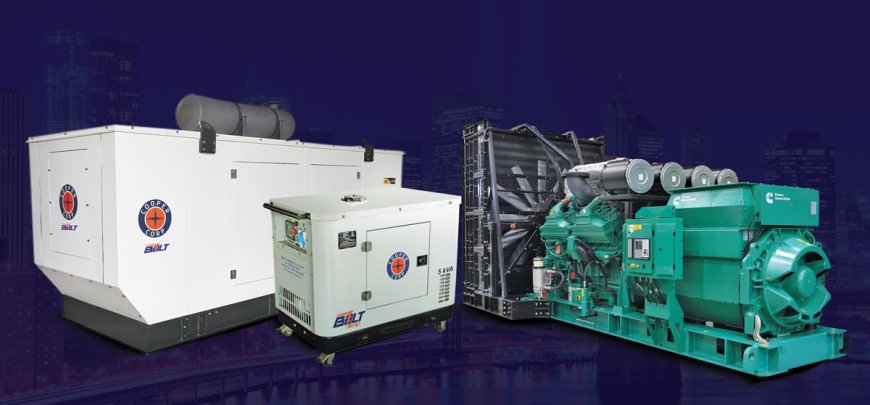On a POWER-PACKED FUTURE
In spite of the prolonged pandemic conditions impacting the overall market, the demand for gensets is expected to prevail in the coming years. Power plays vital role in the overall development of a country as itis among the most critical

In spite of the prolonged pandemic conditions impacting the overall market, the demand for gensets is expected to prevail in the coming years.
Power plays vital role in the overall development of a country as itis among the most critical component of infrastructure, crucial for the economic growth and welfare of nations.
India’s power sector is one of the most diversified in the world. Sources of power generation range from conventional sources to viable non-conventional sources such as wind, solar, and agricultural and domestic waste. Electricity demand in the country has increased rapidly and is expected to rise further in the years to come. In order to meet the increasing demand for electricity in the country, massive addition to the installed generating capacity is required.
Meanwhile, there is also need for emergency power where grid power is not available and during the instance of grid power failure. Generators or gensets are the major source of emergency power for construction, mining and other infrastructure projects applications. It is also used as emergency source of power in commercial buildings, hospitals and big housing societies.
Market dynamics
 The year 2020 saw an unprecedented slowdown in India as well as world over from the impact of Covid-induced lockdown and other challenging situations. The year 2021 was better in spite of the presence of the pandemic with the support of the government measures and the steps taken by the industry players themselves. “However, few segments in the genset business experienced demand in 2020 such as healthcare (Covid-19 readiness centres establishment, expansion and/or upgradation of existing health facilities), IT, particularly Datacenters (work from home as the prevalent model prompted organisations to advance and enhance server capacities), agriculture (for storage, processing, and other support functions) and rental infrastructure (customers deferring capex investment to save cost),” says Mandar Deo, Vice President, Power Systems, Cummins India. According to him, 2021 heralded optimism for the genset business, which experienced a remarkable recovery with demand reaching nearly 95% of the pre-Covid 19 levels of 2019. “Most industry sectors, barring hospitality, and travel observed a significant uptick in demand in the very first quarter of 2021,” he adds.
The year 2020 saw an unprecedented slowdown in India as well as world over from the impact of Covid-induced lockdown and other challenging situations. The year 2021 was better in spite of the presence of the pandemic with the support of the government measures and the steps taken by the industry players themselves. “However, few segments in the genset business experienced demand in 2020 such as healthcare (Covid-19 readiness centres establishment, expansion and/or upgradation of existing health facilities), IT, particularly Datacenters (work from home as the prevalent model prompted organisations to advance and enhance server capacities), agriculture (for storage, processing, and other support functions) and rental infrastructure (customers deferring capex investment to save cost),” says Mandar Deo, Vice President, Power Systems, Cummins India. According to him, 2021 heralded optimism for the genset business, which experienced a remarkable recovery with demand reaching nearly 95% of the pre-Covid 19 levels of 2019. “Most industry sectors, barring hospitality, and travel observed a significant uptick in demand in the very first quarter of 2021,” he adds.
Demand trends
Genset market has evolved over the years with many developments ranging from diesel-powered, gas-based and hybrid equipment. However, diesel powered gensets are still in demand. Deo says, “The diesel-powered genset will continue to retain its position as the primary product in the power backup segment across industry sectors for the foreseeable future. This is due to the ease of availability, maintenance, familiarity with the products and reduced run hours. With steady product improvements such as enhancement of fuel efficiency, carbon footprint reduction, remote monitoring devices and cleaner exhaust, the diesel genset remains a preferred choice for power backup across sectors. While alternative sources of energy and hybrid models are gaining traction in the Indian, industrial, and power backup market, their mass adoption would be heavily dependent on automotive segments transitioning to newer and renewable sources of power.”
 Speaking on the demand-supply scenario, Farrokh Cooper, Chairman & Managing Director, Cooper Corporation, says, “The genset market in India is now expanding because of the growing manufacturing sector and rising need for power for commercial applications. Due to the widespread usage of these gensets in commercial applications such as retail outlets, hotels, telecom towers, offices, and malls, the 5 kVA-75 kVA genset category maintained a significant market share. Increased investment in the telecom sector, the rapid growth of commercial infrastructure, and rising demand for backup and prime power in residential facilities, in my opinion, are driving demand for generators.”
Speaking on the demand-supply scenario, Farrokh Cooper, Chairman & Managing Director, Cooper Corporation, says, “The genset market in India is now expanding because of the growing manufacturing sector and rising need for power for commercial applications. Due to the widespread usage of these gensets in commercial applications such as retail outlets, hotels, telecom towers, offices, and malls, the 5 kVA-75 kVA genset category maintained a significant market share. Increased investment in the telecom sector, the rapid growth of commercial infrastructure, and rising demand for backup and prime power in residential facilities, in my opinion, are driving demand for generators.”
Tech innovations
Diesel gensets being in demand, there are a series of technological innovations happened in the recent past. According to Deo, the diesel genset segment is gearing up for the next CPCB-IV+ (Central Pollution Control Board – IV) emission norms, driving greener products, applicable on nodes up to 910 kVA. “These norms are more stringent than the global Tier 4F norms for certain nodes, aimed at nearly 90% reduction in the CO, NOx, and PM from the previous emission guidelines. For the new norms, Cummins India is investing heavily in the development of robust, competitive, safe, and compliant products,” he adds.
The diesel genset market has seen a slew of technology innovations towards better emission standards. Cooper says, “We design diesel-powered generators that redefine performance efficiency. Our ECOPACK range of DG sets redefines performance efficiency. It is fitted with our four-stroke liquid-cooled gas engines and further equipped with Common Rail Direct Injection (CRDi) technology developed in partnership with Ricardo, PLC. They are fitted with ECU and optimal remote control ECU modules that control all critical engine functions and parameters. The noise levels of our generators range from 75-57 dbA at one metre under free field conditions, much less than any of our competition. Also, they are Euro IV, US Tier IV (interim) and CPCB 2 compliant.”
“Hybrid systems are a game changer in our industry,” says Cooper. “Hybrid energy systems can generate round-the-clock power with cost and reliability levels comparable to gas or diesel plants. Hybrid systems are expected to become increasingly cost-competitive, driven by reducing battery storage and solar energy costs. However, hybrid systems are currently costly due to import duties; if costs come down, there is a better possibility they will be well utilised,” he adds.
Rental market
Leasing and rentals play key role in the growth of genset market due to the growing demand for emergency power in construction and mining projects. With the recovery of demand this year, rental has emerged as a growing segment. “With customers opting to defer the investment in a new asset, rental demand has increased over the last one year,” Deo observes.
On the rental scenario, Cooper adds, “The generator rental business is driven by applications in various industries such as telecommunications, event management, healthcare, power utilities, offshore, oil & gas, mining, infrastructure, shipping, natural disasters, and construction. The decision to rent a generator is made in areas where there are scheduled or unscheduled power outages, internal power system breakdowns, and a need for standby power.”
Outlook positive
The coming year brings a lot of optimism for the genset market though there is threat from Omicron & the increasing cases of Covid. As power is one of the most critical components in infrastructure, back-up power will be in demand, especially in the current challenging conditions.
Hits: 38








